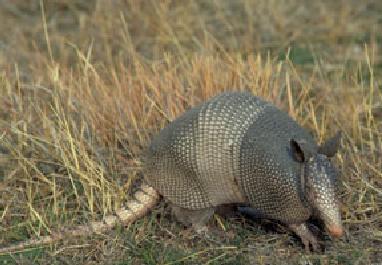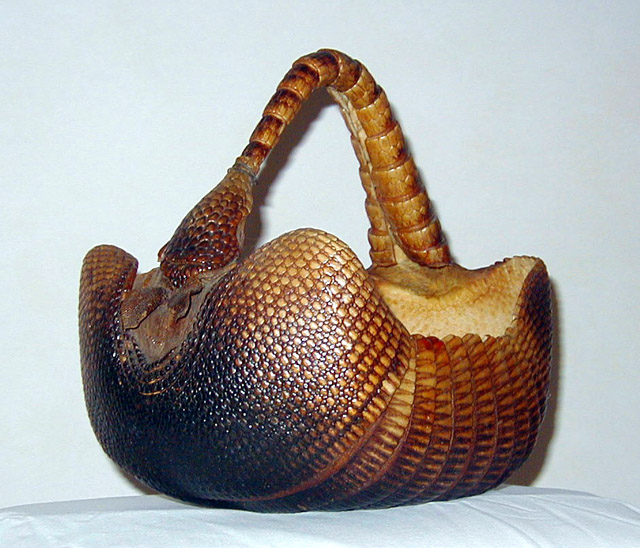ARMADILLO
CARAPACES
(Singular
nouns: Fr-tatou
carapace; Ger- Armadill-/Gürteltier-Rückenschild/Hautpanzer-?;
Nor-beltedyr
???
; Rus-
??? ???)

A. Nine-banded
Armadillo
(Dasypus
novemcinctus Linnaeus, 1758)
-- body length ~38-43cm (15-17 inches); tail ~36-40cm (14-16
inches). (© 2006 Texas Parks and Wildlife Department, from
http://www.tpwd.state.tx.us/)
DESCRIPTION:
Phylum, Chordata; subphylum, Vertebrata; class,
Mammalia; order Xenarthra; family, Dasypodidae; subfamily,
Dasypodinae: Armadillo
carapaces comprise armor-like,
chiefly
dorsal, coverings that consist of several so-to-speak
jointed plates -- e.g.,
seven to eleven on the so-called nine-banded armadillo (Dasypus novemcinctus Linnaeus, 1758).
Similar armor also covers most of the heads, parts of the
legs and occurs as bands around the tails of most armadillos. The plates consist chiefly of
a keratinous layer atop “bony" scutes.
“Baby armadillos [,
however,] have
soft shells, like
human fingernails... [that] get harder as the animal grows,
depositing
bone under the skin to make a solid shell.” (Nixon, 2005).
Colors - grayish to
dark brown, uncommonly with lighter brown or greenish
overtones; babies' carapaces are pink.
H. ~2½
<< an example of
plate-like keratin-rich material.
S.G. ~1.29 << an example of
plate-like keratin-rich material.
Light transmission - keratinous part is
translucent to semitranslucent; underlying bony scutes are
semitranslucent to opaque.
Luster - dull
to waxy
Breakage - irregular
Miscellaneous - The
keratinous layer is roughly leather-like and apparently makes up the
so-called
strip of
skin that occurs between each adjacent pairs of "plates." Hairs
occur sporadically "growing from" the plates.
OTHER
NAMES: I have found none
applied to decorative items fashioned from armadillo. I have,
however, heard them referred to as
Texas turkeys and bushbullits
in Texas slang.
USES:
Baskets
that consist of dried armadillo shells are rather common decorative
items, especially in Texas. The armadillo's banded tail is curled
over the
shell to form a handle of many of these baskets. The head is
retained on some of them.
B. Armadillo
carapace.
Basket fashioned from nine-banded armadillo (Dasypus novemcinctus Linnaeus, 1758) -- see fourth paragraph of
REMARKS. (© photo
by Pat Hines)
Charangos, are small Latin
American guitars, that originally(?) and traditionally(!) have
armadillo shells as the backs of their hollow
bodies
(sound boxes) - see Rumbaut
(1999). They are a
popular instrument in "traditional" Latin American music.
Stuffed armadillos in all
sorts of poses are common showpieces in both commercial
and private
decors -- especially
in Texas. As might be
expected, they also are rather popular souvenirs for tourists. (I
recall that one of
these
was on Judge Harry T. Stone's office desk in the
TV sitcom Night Court.)
Miscellany includes
functional as well as decorative pieces. Many of these functional
pieces also
serve as "show pieces" -- e.g.,
bread "baskets", ice buckets and lampshades.
OCCURRENCES
& NOTEWORTHY LOCALITIES: Several species of
armadillos are native to Latin
America. These, along with the nine-banded armadillo of the United
States east of the
Rockies, mean that armadillos as a group occur as far north as southern
Indiana and
as far south
as the tip of Argentina. "Since they do not
tolerate cold temperatures, several
studies
suggest that further northward [and southward] migration ...
will be limited." (Mengak, 2005), at
least until global warming causes effective climatic changes.
In any
case, currently
"the nine-banded armadillo is the only one found in the United States
... [where it is fairly common in] Texas (east of the Pecos River),
through Louisiana, Mississippi, Alabama, Georgia, Florida, Arkansas,
Oklahoma and the southern portions of Missouri and Kansas" (McPhee,
2004-2005) -- see map available on the internet (Avila, 1999).
REMARKS:
Armadillo
is the diminutive form of the Spanish word armado, apparently meaning "little
armored one." Armado is
derived from the Latin armar,
to arm. These animals were
apparently given this name by the famous Spanish explorer Hernando
Cortez when he first saw them in Mexico in the early 1500s. The
origin for the scientific name Dasypus
novemcinctus is also of
interest. Linnaeus, is said to
have chosen Dasypus,
which in
old Greek refers to hairy footed animals, and, of course, novemcinctus is from Latin and
refers to the nine bands of this species of armadillo.
Treatments used to prepare
armadillos for fashioning baskets etc.
require extensive cleaning to make the armor sanitary.
Subsequent shaping into the marketed objects include diverse
processes -- e.g., baskets
involve bending the tail and
attaching it to the head to provide a handle, and most are lined with
cloth, which is usually sewn into the carapace; also, some are
painted, etc.
"About two million
years ago a relative of the armadillo as large as a rhinoceros lived in
South America and small cousins lived as far north as Canada. These [,
however,] disappeared in the Ice Ages long before humans inhabited
North
America." (Mengak, 2005).
Charles
Apelt,
a German basketmaker from Comfort, Texas, is said to have been the
"inventor" of the Armadillo-shell basket. Be this fact or
fiction, his display of such baskets at the New York 1902 World’s
Fair established its role on the kitsch marketplace. The Apelt
Armadillo Company, which included a farm on which armadillos were
raised, was a family enterprise that lasted until 1971 and is reported
to have "shipped out hundreds of thousands of baskets, lamps, and other
items ... more than twenty thousand armadillos and armadillo products
in a single year." (Smith and Doughty,
1984, p.55). In addition, it
supplied live armadillos to individuals, research laboratories and zoos.
"Armadillos have
been the subject of medical and scientific research in the reproductive
physiology and genetics because of their unique abilities to clone...
They are also used in leprosy [Hansen's disease] research. ... They are
the only animal other than man that will consistently grow the
[leprosy] bacilli
under laboratory conditions. [Consequently,] Because of their unique
susceptibility to leprosy they have been used to develop a vaccine
against this ancient disease.” (McPhee, 2004-2005). Additional
information about armadillos and medical research are outlined by Klemm
(2007).
In the late
1970s,
a proposal to name the armadillo as the official state mammal of Texas
was defeated. But, "in October1981, when Senator Ogg, serving as
president pro tempore of the
Senate, was sworn in as 'Governor for a
day' ... [he] used his status to declare the armadillo the 'official
state mascot' by executive decree." (Smith and Doughty, 1984, p.96)
An especially complete article about armadillos is given by Nixon
(2005). Several bits of interesting information about armadillos
are given by
Smith and Doughty (1984).
SIMULANTS: None, so far as I
know, although some of the fashioners and marketers of "armadillo
purses" made of fabrics that closely resemble armadillos might
disagree; in any case, I cannot see how anyone would ever
misidentify any of these purses as fashioned from an
armadillo.
REPLICAS: Relatively small
pewter and
sterling silver replicas, some of which are covered with, for example,
turquoise, have been fashioned and sold as pendants, pins, etc.; armadillo-shaped
fetishes have been carved from such things as pipestone (see GemRocks
entry ARGILLITE), and the armadillo has
served as the model/inspiration for all sorts
of so-called works of art (e.g.,
beadwork items,
cartoons, ceramics, etchings, jewelry, mosaics, paintings, prints,
puppets and
wood carvings). One wood carving
genre is especially "eyecatching" -- labeled as an Oaxacan
carving,
it is
noted as "whimisical and enchanting[,] ... imaginative and brilliantly
colored [,] ... hand-carved (from native Copal wood) and hand-painted
...[by] the Zapotec Indians of Southern Mexico." (catalog of
marketer); if the illustration given is a good representation,
the descriptive
terms are understatements! Klemm (op. cit.) also records
mahogany Costa Rica carvings, metal sculptures and concrete statuary
replicas of armadillos. Size- and else-wise, "The Armadillo" --
Sir Norman Foster's world-famous convention and
entertainment venue on the River Clyde in
Glasgow, Scotland, is perhaps the most impressive of all replicas of
zoogenic creatures.
R.V.
Dietrich © 2015
Last update: 10 March 2008
web page created by Emmett Mason


